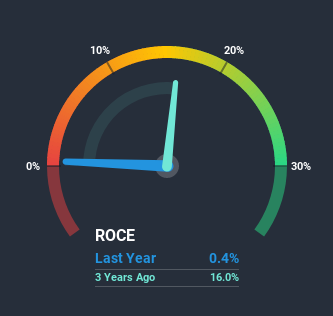Should You Be Impressed By Stoneridge's (NYSE:SRI) Returns on Capital?
What trends should we look for it we want to identify stocks that can multiply in value over the long term? Firstly, we'll want to see a proven return on capital employed (ROCE) that is increasing, and secondly, an expanding base of capital employed. Basically this means that a company has profitable initiatives that it can continue to reinvest in, which is a trait of a compounding machine. In light of that, when we looked at Stoneridge (NYSE:SRI) and its ROCE trend, we weren't exactly thrilled.
Understanding Return On Capital Employed (ROCE)
If you haven't worked with ROCE before, it measures the 'return' (pre-tax profit) a company generates from capital employed in its business. Analysts use this formula to calculate it for Stoneridge:
Return on Capital Employed = Earnings Before Interest and Tax (EBIT) ÷ (Total Assets - Current Liabilities)
0.0042 = US$2.0m ÷ (US$621m - US$146m) (Based on the trailing twelve months to December 2020).
So, Stoneridge has an ROCE of 0.4%. In absolute terms, that's a low return and it also under-performs the Auto Components industry average of 9.3%.
Check out our latest analysis for Stoneridge
Above you can see how the current ROCE for Stoneridge compares to its prior returns on capital, but there's only so much you can tell from the past. If you'd like, you can check out the forecasts from the analysts covering Stoneridge here for free.
What Can We Tell From Stoneridge's ROCE Trend?
In terms of Stoneridge's historical ROCE movements, the trend isn't fantastic. Around five years ago the returns on capital were 11%, but since then they've fallen to 0.4%. And considering revenue has dropped while employing more capital, we'd be cautious. If this were to continue, you might be looking at a company that is trying to reinvest for growth but is actually losing market share since sales haven't increased.
The Bottom Line On Stoneridge's ROCE
In summary, we're somewhat concerned by Stoneridge's diminishing returns on increasing amounts of capital. Yet despite these poor fundamentals, the stock has gained a huge 129% over the last five years, so investors appear very optimistic. Regardless, we don't feel too comfortable with the fundamentals so we'd be steering clear of this stock for now.
Stoneridge does have some risks though, and we've spotted 1 warning sign for Stoneridge that you might be interested in.
While Stoneridge may not currently earn the highest returns, we've compiled a list of companies that currently earn more than 25% return on equity. Check out this free list here.
This article by Simply Wall St is general in nature. It does not constitute a recommendation to buy or sell any stock, and does not take account of your objectives, or your financial situation. We aim to bring you long-term focused analysis driven by fundamental data. Note that our analysis may not factor in the latest price-sensitive company announcements or qualitative material. Simply Wall St has no position in any stocks mentioned.
Have feedback on this article? Concerned about the content? Get in touch with us directly. Alternatively, email editorial-team (at) simplywallst.com.

